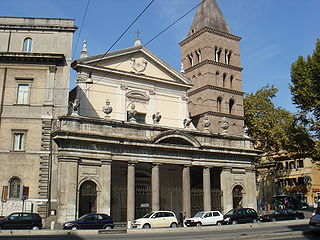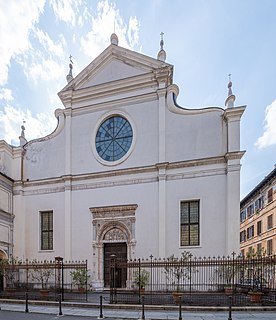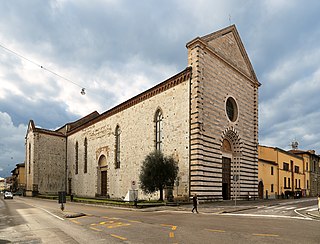Related Research Articles

Santa Pudenziana is a church of Rome, a basilica built in the 4th century and dedicated to Saint Pudentiana, sister of Saint Praxedes and daughter of Saint Pudens. It is one of the national churches in Rome, associated with Filipinos.

Santa Maria dei Miracoli and Santa Maria di Montesanto are two churches in Rome.

Castelseprio was the site of a Roman fort in antiquity, and a significant Lombard town in the early Middle Ages, before being destroyed and abandoned in 1287. It is today preserved as an archaeological park in the modern comune of Castelseprio, near the modern village of the same name. It is in the north of Italy, in the Province of Varese, about 50 km northwest of Milan.

San Crisogono is a church in Rome dedicated to the martyr Saint Chrysogonus. It was one of the tituli, the first parish churches of Rome, and was probably built in the 4th century under Pope Sylvester I (314–335), rebuilt in the 12th century by John of Crema, and again by Giovanni Battista Soria, funded by Scipione Borghese, in the early 17th century.

Santa Maria Maddalena dei Pazzi is a Renaissance-style Roman Catholic church and a former convent located in Borgo Pinti in central Florence.

Santa Maria dei Servi is a Roman Catholic basilica in Bologna, Italy.

Santi Vito e Modesto is a Roman Catholic church, and appears to have two facades, a 20th-century marble facade on Via Carlo Alberto, but a rustic brick older entrance, in reality the apse, on the Via San Vito in the Rione Esquilino of Rome, Italy. It has also been called Santi Vito, Modesto e Crescenzia. It is located, adjacent to the Servian Wall, near the former Monastery of the Viperesche.

The Abbey of Santa Maria di Rovegnano is a Cistercian monastic complex in the comune of Milan, Lombardy, northern Italy. The borgo that has developed round the abbey was once an independent commune called Chiaravalle Milanese, now included in Milan and referred to as the Chiaravalle district.

Santa Maria in Trivio is a church in Rome. It is dedicated to Mary, mother of Jesus, and is located on Piazza dei Crociferi in rione Trevi. It is near the Fountain of Trevi.

Santa Maria alla Porta is a church in Milan, Italy.

Longobards in Italy: Places of Power is seven groups of historic buildings that reflect the achievements of the Germanic tribe of the Lombards, who settled in Italy during the sixth century and established a Lombard Kingdom which ended in 774 A.D.

Santa Maria in Calanca Castle is a tower in the municipality of Santa Maria in Calanca of the Canton of Graubünden in Switzerland. It, along with the neighboring Church of the Assumption of St. Mary, are both Swiss heritage sites of national significance.

San Martino church, also called San Martino Maggiore is a Gothic-style, Roman Catholic church located at the corner of Via Marsala and Via Guglielmo Oberdan in Bologna, region of Emilia Romagna, Italy. The church was founded by the adjacent Carmelite monastery. In August 1941 Pope Pius XII elevated it to the status of a minor basilica.

The church of Santa Maria delle Grazie in Brescia is located on at the west end of Via Elia Capriolo, where it intersects with the Via delle Grazie. Built in the 16th century and remodeled in the 17th century, it still retains much of its artwork by major regional artists, including one of its three canvases by Moretto. The other two are now held at the Pinacoteca Tosio Martinengo. The interior is richely decorated in Baroque fashion. Adjacent to the church is the Sanctuary of Santa Maria delle Grazie, a neo-gothic work.
Santa Maria dell'Angelo, also known as Santa Maria Nuova is a Baroque architecture, Roman Catholic church, erected by the Jesuit Order on Via Santa Maria dell'Angelo in Faenza, Italy.

Santa Maria Infraportas is a medieval church and chapel in Foligno, Italy.
The Church of the Carmine or Santa Maria del Carmine is a Roman Catholic religious building located attached to an adjacent convent in Faenza, region of Emilia-Romagna, Italy.

Santa Maria or Santa Maria a Campi is a Roman Catholic parish church located on Via Spartaco Lavagnini #26 in Campi Bisenzio, just west of Florence, in the region of Tuscany, Italy.

San Francesco is a Gothic-style, Roman Catholic church located on the piazza of the same name in Pistoia, region of Tuscany, Italy.

The Cappella di San Luca, also called dei Pittori is a chapel found in the cloisters of the convent of Santissima Annunziata in Florence, Italy. It was built to serve as the burial chapel for members of the Accademia del Disegno, and was donated by the Servites to the Academy in a document from 1565. It contains a collection of terracota statues from a number of prominent Florentine Mannerist sculptors.
References
- ↑ Ufficio informazioni turistiche di riferimento: I.A.T. Faenza; Tourism information office of Faenza.